With Graduation behind me and in between Summer classes, I am finally exploring the streets below 23rd Street. I never thought I would get here. It had been two long semesters and the Christmas from hell. I don’t think my feet ever hit the floor. I just kept going.
I finally got back to the Flatiron District. This is where the lines get a blurry with the neighborhoods. The Flatiron District overlaps with Union Square which overlaps with Gramercy Park. NoMAD mixes with the Flatiron District and Rose Hill and then Kips Bay and Gramercy Park again. It gets very confusing so I just repeat the roads in other neighborhoods. Since the official southern border of the Flatiron District is West 20th Street, I looked to the neighborhood to walk.

The Lower Flatiron District by McCreery’s Department store on 15th Street.
I decided to defy what the relators say and I cut the neighborhoods by Avenues. I decided that Lower Flatiron District would be from West 20th to West 14th Streets between Sixth and Fifth Avenues. Union Square would be from West 20th to West 14th Streets between Fifth and Irving Place. From there I would finish Gramercy Park past Irving Place and then Lower Chelsea from West 23rd to West 14th Street from Sixth Avenue to Twelve Avenue. Have I confused you yet? It is for me and I am not sure if the residents of these communities know what neighborhood association to join.
I started my walk along the northern section of the neighborhood which I had walked before the semester had started at NYU. I started on West 20th Street and it was like visiting an old friend. It was then I realized that I had not walked this neighborhood in two years and that a lot had changed in that time. I had finished walking it in 2022 before Grad school had even started.
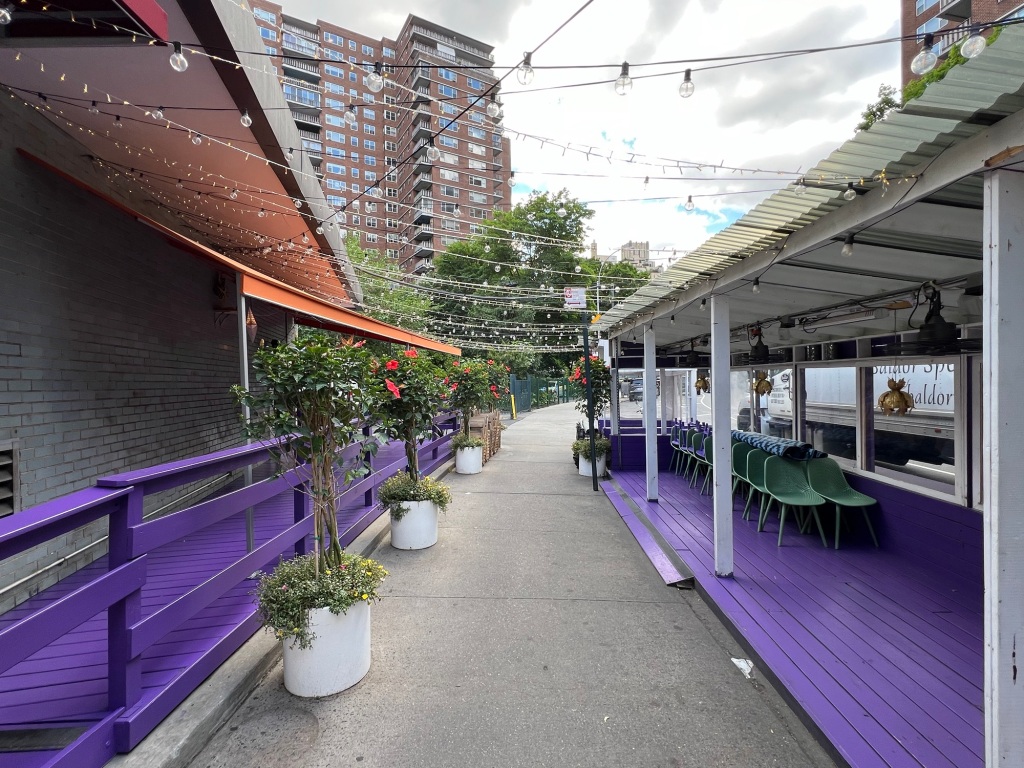
Walking through Chelsea to West 20th Street. I love how the purple in this restaurant stands out every summer. I walked through the outside seating to Shukette, a restaurant at 230 Ninth Avenue.
Review on TripAdvisor:
At the corner of Sixth Avenue and West 20th Street, another building got my attention at 650 Sixth Avenue. This impressive building, which is known as the Cammeyer and is located at 650 Avenue of the Americas on the southeast corner at 20th Street, was converted to a residential condominium in 2007 (Carter Horsley. CityRealty.com).

650 Sixth Avenue at the corner of Sixth Avenue and West 20th Street-Now the Cammeyer
https://www.cityrealty.com/nyc/chelsea/the-cammeyer-650-sixth-avenue/review/30381
https://streeteasy.com/building/the-cammeyer
http://daytoninmanhattan.blogspot.com/2010/09/1892-cammeyer-building.html
The building was designed by Hubert, Piersson & Hoddick in 1892 for the estate of William C. Rhinelander. The red-brick, Neo-Renaissance-style building has white stone and terra cotta trim, a large copper cornice and a handsome band course beneath its top floor. It was the home of the Cammeyer Shoe Store, the one of the largest shoe stores in country (Daytonian).
The conversion was designed by Perkins Eastman for by Penterium, the residential development arm of Korean firm Kumang Housing Corp (Carter Horsley. CityRealty.com).
I was admiring 27 West 20th Street on my walk down West 20th Street to Park Avenue South. This detailed twelve story office building was built in 1908 and now offers loft style offices. the details of the building include elaborate stonework both around the doorways and lower windows and the top floors.

27 West 20th Street was built in 1913
What I liked about the side streets as well as the avenues as I walked the neighborhood was that it kept its character and that these buildings had not been knocked down for the modern skyscraper. They were finding new use like the buildings in Midtown South and in NoMAD and become very desirable.
There was true beauty in the details of 20 West 20th Street that was built in 1906. The Beaux Art style details around the windows and doors accent the elegant building.

20 West 20th Street
https://www.squarefoot.com/building/ny/new-york/20-west-20th-street
https://www.loopnet.com/Listing/20-W-20th-St-New-York-NY/17521377/
This is also the details you see in the office building of 10 West 20th Street built in 1903 with Beaux Art style details along the lower windows and doors and the upper floors of the building.

10 West 20th Street

The embellishments of 10 West 20th Street
https://www.emporis.com/buildings/151673/10-west-20th-street-new-york-city-ny-usa
I passed 156 Fifth Avenue as I crossed the border from west to east in this part of the neighborhood and admired it for its detailed stonework carving and unusual styled roof. The Presbyterian Building was built in 1893 and was designed by architect James B. Baker and was designed in the French Gothic style. It was to be used by the Presbyterian Church as their base for domestic and foreign missions and used as office space. The Panic of 1893 changed that, and they had to lease the space out (Daytonian in Manhattan).
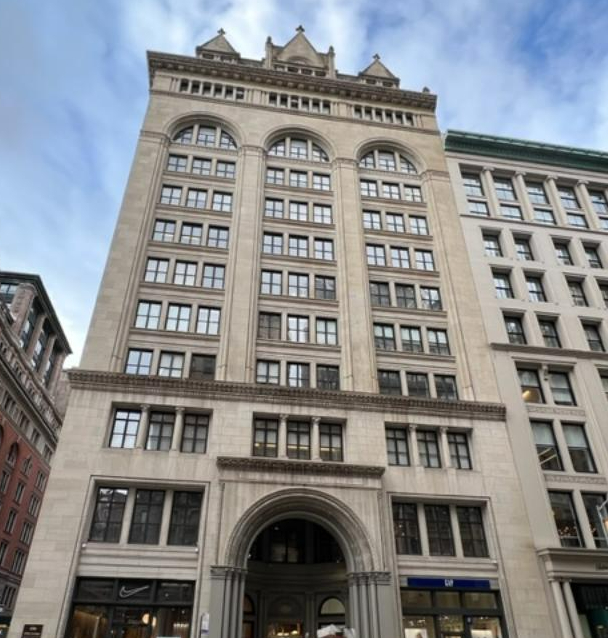
156 Fifth Avenue
https://www.loopnet.com/Listing/156-Fifth-Ave-New-York-NY/14050649/
http://daytoninmanhattan.blogspot.com/2011/02/presbyterian-building-156-fifth-avenue.html
I then took the long walk down Fifth Avenue and all the architectural treasures it contains. This was once the core of the old ‘Midtown Manhattan’ after the Civil War and the City started its march uptown.

148 Fifth Avenue
https://streeteasy.com/building/148-5-avenue-new_york
https://www.loopnet.com/property/148-5th-ave-new-york-ny-10011/36061-08210041/
This unique office building was built in 1900 as a office building. This building is currently under renovation.
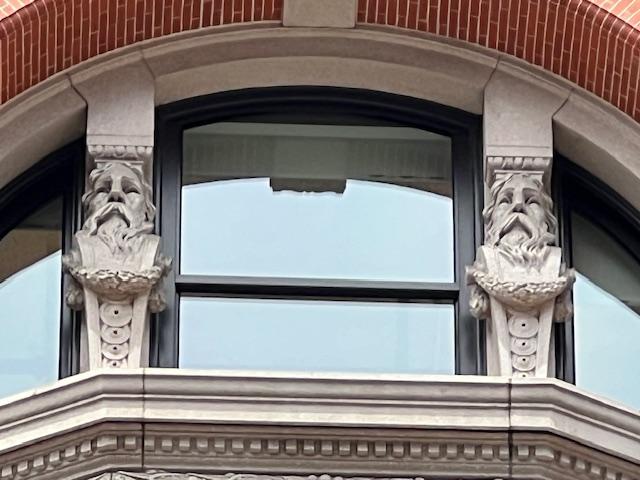
The details on 148 Fifth Avenue

The details of 148 Fifth Avenue
The next interesting building on the walk down Fifth Avenue was 119 Fifth Avenue which had just finished being renovated.

119 Fifth Avenue
https://www.propertyshark.com/mason/Property/13021/119-5-Ave-New-York-NY-10003/
https://streeteasy.com/building/119-5th-avenue-new_york
119 Fifth Avenue at the corner of East 19th Street in the Flatiron District neighborhood of Manhattan, New York City was built in 1905-06 and was designed by John H. Duncan in the neo-Renaissance style. It was built to be an annex to the Lord & Taylor department store buildings which took up most of the square block between Broadway and Fifth Avenue and East 19th and 20th Streets, being connected by bridge to two of them. After Lord & Taylor moved uptown in 1914, the building had multiple uses (Wiki).

The details of 119 Fifth Avenue
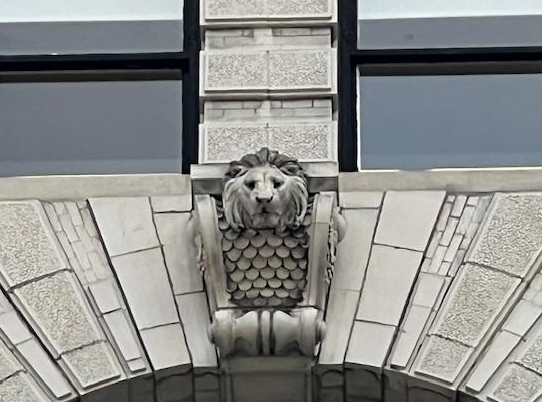
The details of 119 Fifth Avenue
One of the most impressive buildings in the neighborhood is the old Arnold Constable Store building that stretches from its Broadway entrance down the entire block on 18th Street to its Fifth Avenue entrance.

115 Fifth Avenue-Arnold Constable Department Store
https://buildingsofnewengland.com/tag/115-fifth-ave-nyc/
https://en.wikipedia.org/wiki/Arnold_Constable_%26_Company
https://www.realtyhop.com/building/115-5th-avenue-new-york-ny-10003
This seven-story department store building was designed by architect Griffith Thomas in 1868 for the prominent dry-goods company of Arnold Constable & Company. ‘The Palace of Trade’ as it became known as, is located stretches between Broadway and Fifth Avenue. The stunning Second Empire building is faced in marble, brick, and cast-iron, features stacked arch orders and a prominent, two-story, pavilioned mansard roof. Arnold Constable & Co. was founded by Aaron Arnold, who opened a small dry goods store in the city in 1825 (Buildings of New England).
As the business prospered he moved into larger quarters numerous times. In 1842, James Constable, an employee, married Arnold’s daughter Henrietta and was subsequently made a partner. From this, the company was renamed Arnold Constable & Co. In its heyday, Arnold Constable & Co. was the largest dealer to the elite in New York City, supplying the latest fashions to a clientele that included the leading families in the city (Buildings of New England).
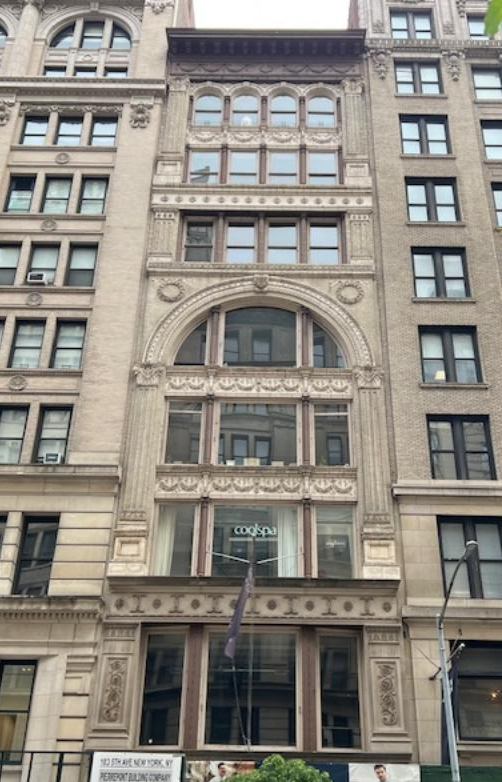
103 Fifth Avenue
https://streeteasy.com/building/103-5-avenue-new_york
https://daytoninmanhattan.blogspot.com/2011/07/1896-beaux-arts-pierrepont-building-103.html
interesting history. The building was designed by architect Louis Korn and was designed in the Beaux-Arts design. It was completed in 1896 and it was named after Edwards Pierrepont, whose mansion had stood on the site before the construction of the building. When it opened the building was popular small publishing and mercantile companies (Dayonianinmanhattan.com).

The 103 Fifth Avenue details
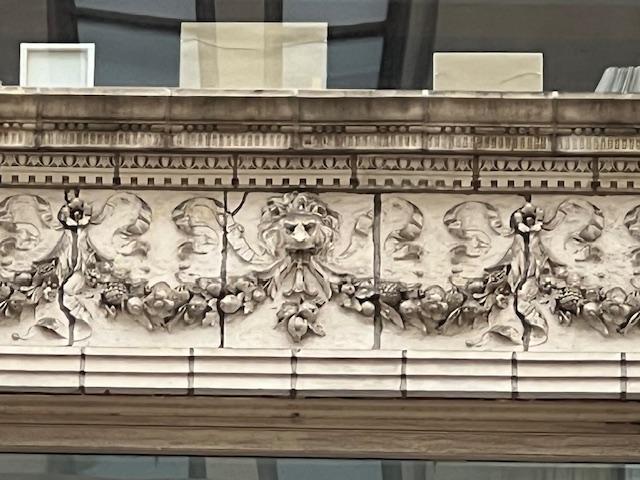
103 Fifth Avenue embellishments
In between the buildings there was plaque to Levi Parsons Morton, the former Governor of New York State and the Vice-President of the United States under President Benjamin Harrison. This is where his home was located.

The plaque of the former Vice-President’s home on Fifth Avenue.

Vice-President and former New York Governor Levi Parsons Morton
https://en.wikipedia.org/wiki/Levi_P._Morton

The B. Shackman & Company sign
https://ephemeralnewyork.wordpress.com/tag/b-shackman-co/
The B. Shackman & Company sign was for the former B. Shackman & Company novelty and toy store that was located here until the 1970’s. The store once sold all sorts of novelties and gifts (Ephemeral New York.com/Consumer Grouch).
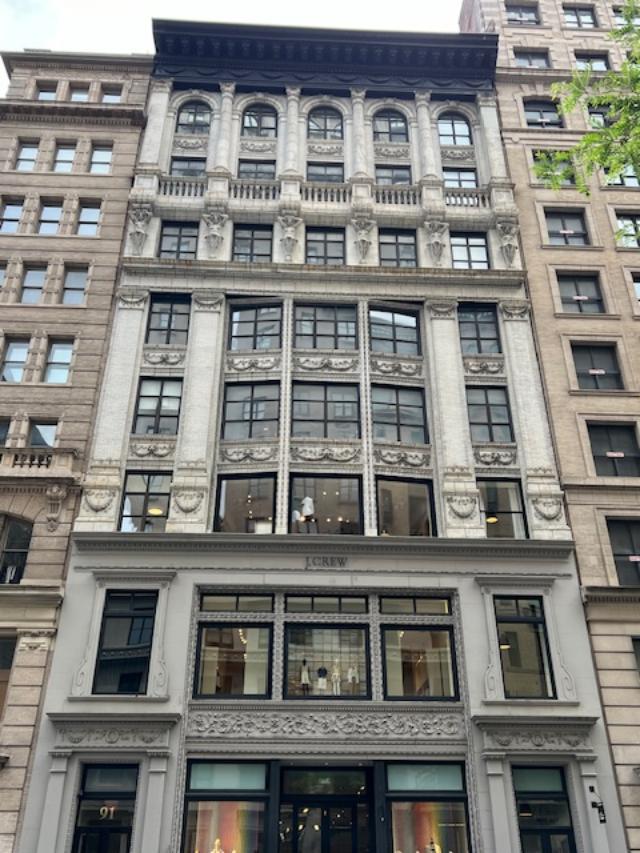
91 Fifth Avenue
https://www.propertyshark.com/mason/Property/12971/91-5-Ave-New-York-NY-10003/
This beautiful office building was designed by architect Louis Korn for businessmen Henry and Samuel Korn in 1896. The office building currently houses small companies (Wiki).
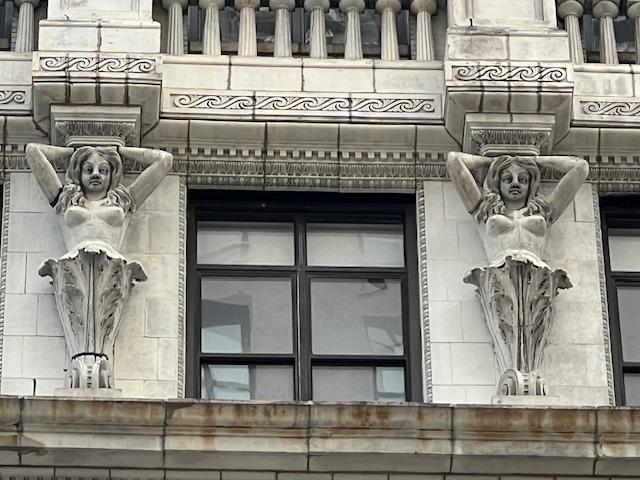
The details of women looking down at us on the street at 91 Fifth Avenue
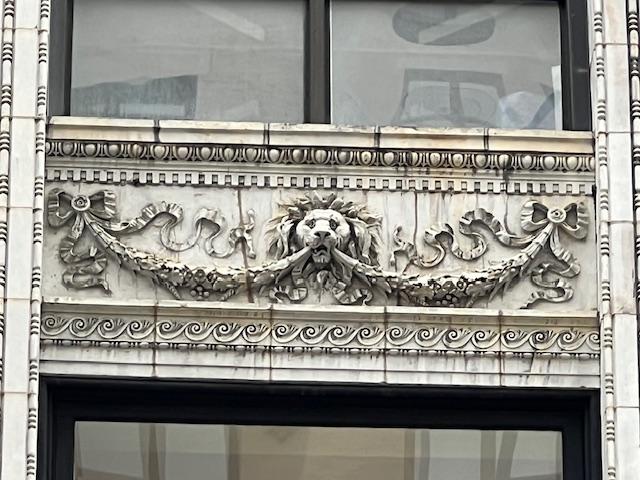
The lion details on 91 Fifth Avenue.
The last building on this part of Fifth Avenue was under an extensive renovation and I was not able to get the pictures that I wanted but still you could see the details in the building around the renovations.

Looking up Fifth Avenue from 16th Street
The Kensington Building was designed by architect Samuel Sass in the Beaux-Arts design and completed in 1906. Some of the first tenants of the building was the Milton Bradley company. The building was converted into a residential building in 1996 and were designed by architect Joseph Pell Lombardi (Landmark Branding LLC).

73 Fifth Avenue
https://www.cityrealty.com/nyc/flatiron-union-square/the-kensington-73-fifth-avenue/4044
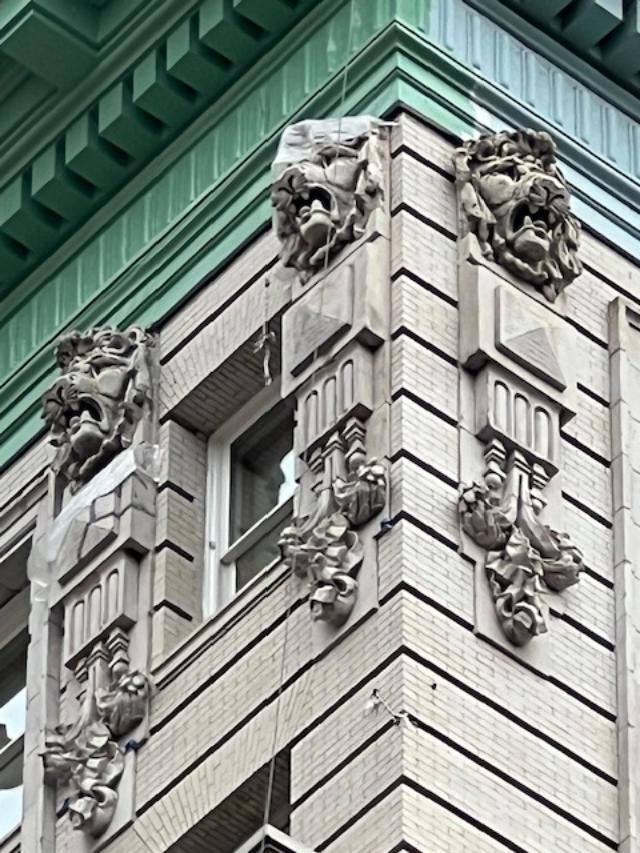
The details on 73 Fifth Avenue
This part of Fifth Avenue has kept its character all these years and now that these buildings are back in vogue because of their history and design detail, they are being refitted for modern times. These were once the headquarters of companies that are now long gone but are housing the new future companies leading us into the 21st Century.

Looking up Fifth Avenue from 15th Street and the core of the Lower Flatiron District.
West 14th Street is a Hodge podge of building types and in various conditions. COVID really hit 14th Street businesses hard and between the pandemic, urban renewal of the neighborhood and changing tastes of building types, there is only a few buildings left from the era when this was a major shopping street at the turn of the last century. This was before everything moved up to the 23rd Street and Sixth Avenue area.
Much of the block between Fifth and Sixth Avenue is in the process of being knocked down, renovated or both. Still there are some architectural gems still left on the street.
On the corner of Fifth Avenue and West 14th Street is 80 Fifth Avenue.

80 Fifth Avenue from the corner view
https://www.loopnet.com/Listing/80-Fifth-Ave-New-York-NY/4632221/
80 Fifth Avenue is an elaborately-detailed Renaissance Revival style office building that was constructed by the architecture firm of Buchman and Fox. This building was constructed in 1908 to be used as manufacturing and office space (Kates, Ariel. Off the Grid).

Seeing better detail work on the building from the West 14th Street view.
This beautiful building’s lower and upper levels feature decorative floral and geometric ornamentation, elaborate cornices, and angled bay windows on the third floor. Ornamented pilasters are found at either side of these windows, with slightly more austere middle floors and in its arched windows and elaborate ornamentation at the top story (Kates, Ariel. Off the Grid).
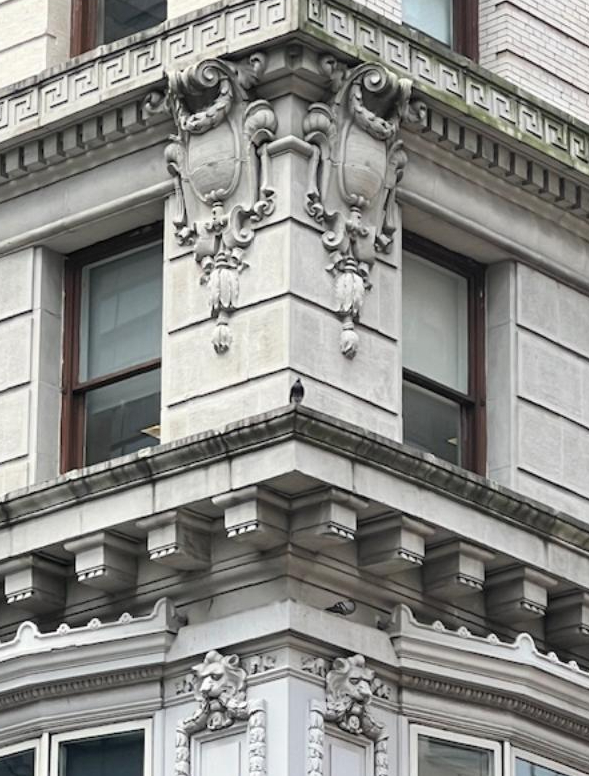
The beautiful detail work on 80 Fifth Avenue.
The building’s history has a long past of companies that have worked in these offices but the most prominent had been the creation of the gay organization, The National Gay Task Force. Among the Task Force’s accomplishments during the time it was located at 80 Fifth Avenue included getting the American Psychiatric Association to end its classification of homosexuality as a mental illness; getting the federal government to end its ban on employing gay or lesbian people in any federal agencies (Kates, Ariel. Off the Grid).
Walking past buildings that are being renovating or built much of what must have been there from the turn of the last century had been torn down and that beauty in the buildings that must have been the ‘Ladies Shopping District’ in the early 1900’s. The only other building on West 14th Street that had the same characteristics and beauty is 56 West 14th Street by the corner of West 14th and Sixth Avenue.

56 West 14th Street-The former R. H. Macy Annex
https://daytoninmanhattan.blogspot.com/2023/06/the-r-h-macy-co-annex-56-west-14th.html
This Neo-Classically designed building was the annex to the original Macy’s store that stood at the corner of Sixth Avenue and West 14th Street. R.H. Macy Dry Goods originally opened in a small building (since demolished) on this corner in 1858, and as its success grew it expanded into a number of neighboring buildings. No. 56 was built in 1898 by then-owners Isador & Nathan Straus. It was designed by architects William Schickel and Isaac E. Ditmars (Moskowitz, Sam Off the Grid).

The elaborate embellishments of 56 West 14th Street

The interesting details of the building.
Four years later, in 1902, the department store moved uptown to it’s present location on Herald Square, which is the current headquarters of the store.
Walking up Sixth Avenue towards West 20th Street, there is again the same issue. Most of the more elaborate buildings are closer to the edge of West 20th Street. Walking back up toward the heart of the former “Ladies Garment Mile” along Sixth Avenue from West 18th Street to West 23rd Street, the lower part of Sixth Avenue is similar in look to West 14th Street. A mish-mosh architectural styles from years of knocking down the older buildings. Inside are a variety of fast food restaurants, coffee shops and small stores.
The first building left of the former shopping district is the former Pace Building at 610 Sixth Avenue.
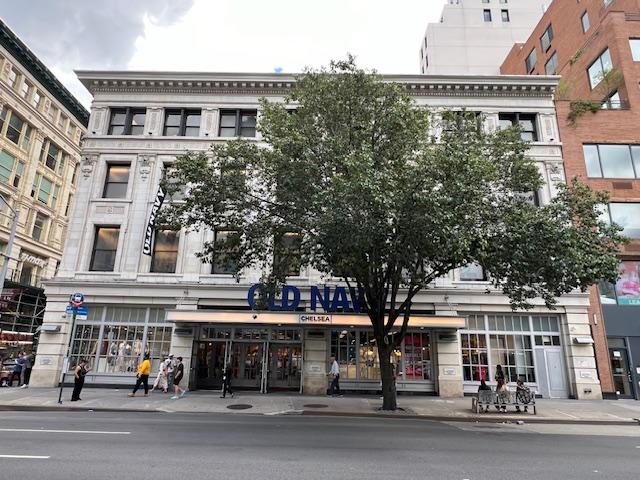
610 Sixth Avenue-The former Price building
https://daytoninmanhattan.blogspot.com/2018/06/the-price-buildling-604-612-sixth-avenue.html
David Price opened his first women’s clothing store, D. Price & Co. around 1887. The Price Building was built in 1910-1912 and designed by Buchman & Fox in the Beaux-Arts style (Wiki). The was the combination of the two stores, the one facing Sixth Avenue and the one facing 18th Street (DaytoninManhattan.com).

The embellishments of 610 Sixth Avenue designed by Buchman & Fox.
Next to the Price Building is what was one of the grandest of the department stores in New York City at 620 Sixth Avenue, Seigel Cooper
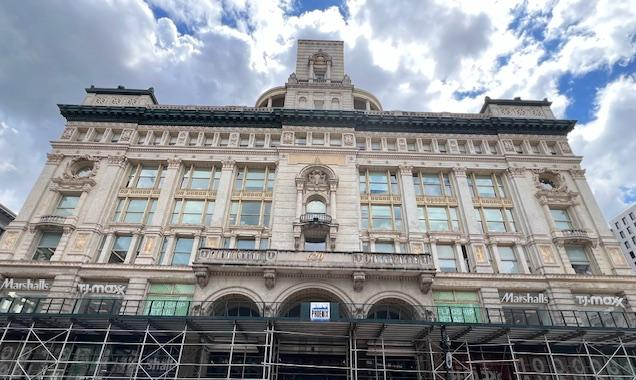
620 Sixth Avenue-The former Siegal Cooper Department Store
https://en.wikipedia.org/wiki/Siegel-Cooper_Company

The original store design in the late 1800’s (New York Historical Society)
The Siegel-Cooper Department store was a Chicago based store that was founded in 1877 by Henry Siegel, Frank H. Cooper and Isaac Keim. They opened the New York City store in 1896 on the Ladies Mile Shopping District. The store was designed by the architectural firm of DeLemons & Cordes in the Beaux-Arts design. When it opened, it was the largest department store in the world until Macy’s opened in 1902 (Wiki).
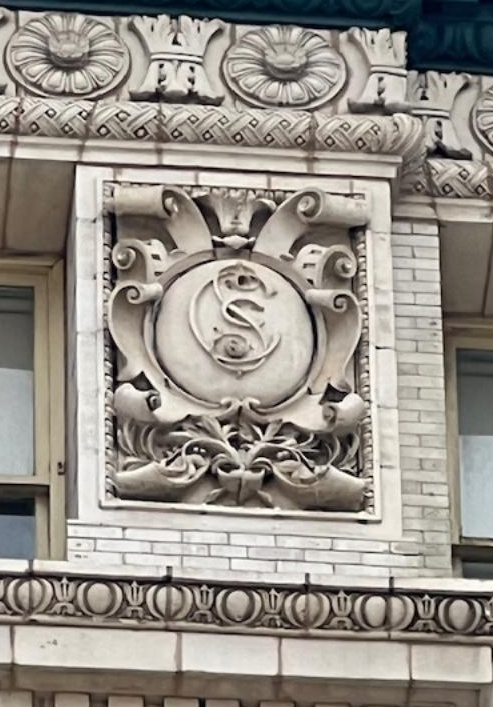
The Siegal Cooper insignia on the building.
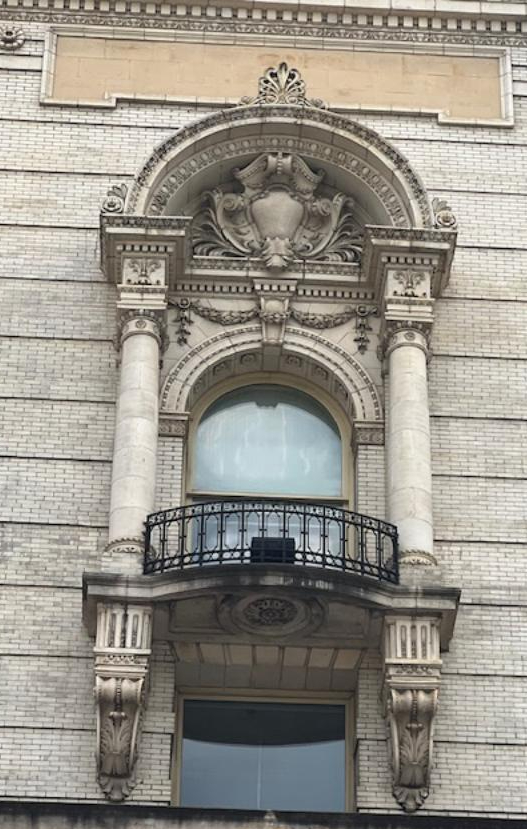
The window details
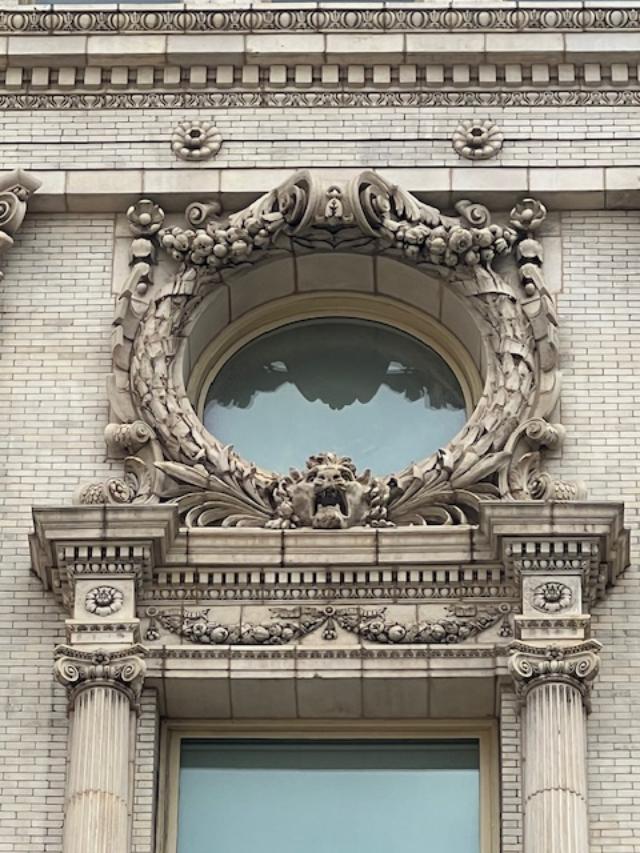
The details on the upper windows of the store.
Henry Siegel over-extended himself and sold the company in 1902 to an investor and the store declared bankruptcy in 1915 and closed in 1917. After the store closed, it was used as a military hospital and then as a warehouse. Today after years of being used as a warehouse, it now has several retailers located in the store space (Wiki).
Across the street from the Siegel-Cooper store is the old B. Altman & Company store before they moved to East 34th Street.
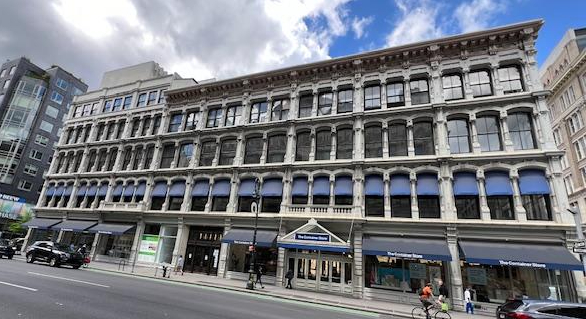
625 Fifth Avenue-The old B. Altman & Company Department Store.
https://en.wikipedia.org/wiki/B._Altman_and_Company
https://untappedcities.com/2021/10/20/lost-new-york-city-department-store-b-altman/
B. Altman & Company was founded in 1865 as a family store that eventually came under the control of Benjamin Altman. It moved from its Third Avenue and Tenth Street location to 621 Sixth Avenue in 1877. The store expanded four times in this location to cover what is now 625 Sixth Avenue. The store was designed in the Neo-Grec design and built in four stages. First by architects David and John Jardine for the original store in 1877 and then the extension in 1880. Then by architect William Hume in 1887 and then by architects Buchman & Fox in 1910. The store moved to the corner of Fifth Avenue and 34th Street in 1906 when the shopping district moved to 34th Street (Wiki).
The last old department store on the Ladies Mile Shopping District is at 641 Sixth Avenue on the corner of Sixth Avenue and West 20th Street.

641 Sixth Avenue-The old Simpson Crawford Department Store
Simpson Crawford like many stores on Sixth Avenue had its humble beginnings on 19th Street. The store continued to grow and expand catering to the ‘carriage trade’ and selling the finest merchandise. After their new store was destroyed in a fire in 1880, they opened the store at 641 Sixth Avenue in 1899 which was designed by architectural firm William H. Hume & Son in the Beaux-Arts design (dayoninmanhattan.com).
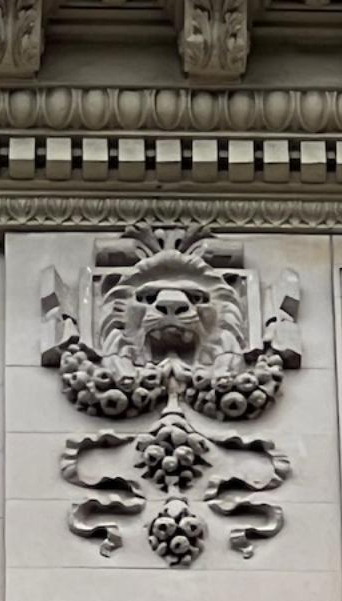
The details of 641 Sixth Avenue.
This part of the Flatiron District feels so different from the northern part of the neighborhood. So much of it has disappeared over the years that the character has changed. It does not have the distinction of the blocks between 23rd and 20th streets. There are blocks of these types of buildings whereas the blocks of the old shopping districts of the early to late 1800’s from 14th to 18th Streets have slowly disappeared over time. Older buildings have since been replaced with modern office and apartment buildings. The buildings have even been refitted for apartments and for the growing college campuses in the area.
While there are many architectural gems in this neighborhood, it just goes to show the progression of Manhattan and how things have changed in the last 100 years. The City keeps marching on. Still this section of the Lower Flatiron District shows just how important this part of the old “Midtown Manhattan” was from the Civil War until WWI. Just look up and admire all the details on each building. There are a surprise and delight for the eyes.
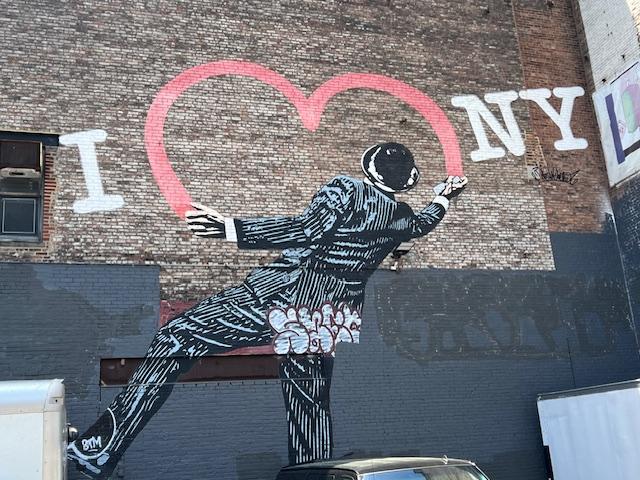
The Street art on West 15th Street off Sixth Avenue “I Love New York”
Read my blog on Walking the Streets of the Lower Flatiron District:
